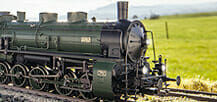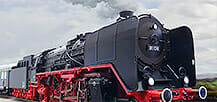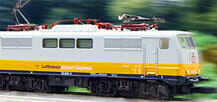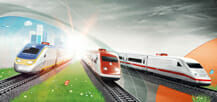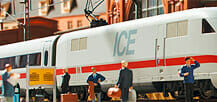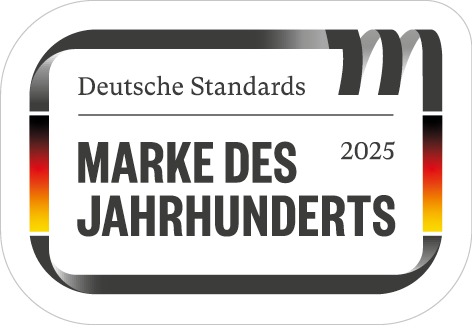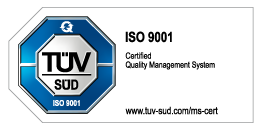Class 03.10 Steam Locomotive
The High Stepper from the Hagen-Eckesey Maintenance Facility
In 1949 and 1950 the 26 class 03.10 steam locomotives remaining on the German Federal Railroad roster after World War II were extensively modernized at Henschel in Kassel. Here the streamlining among other things was removed. In 1954, these locomotives were given welded Krupp high-performance boilers with combustion chambers. Still later they were given newly designed tenders with replenishing equipment as well as coal bunker hatches. Everything was converted and later contributed to its distinction.
In addition, these steam locomotives were equipped with the technically latest control equipment at that time. They had a multiple valve superheated steam controller. However, this was unpopular with the crews and was difficult to operate, which can be explained among other things with the controller parallelogram executed with great difficulty.
In the fall of 1958, all 26 units were transferred and brought together at the maintenance facility at Hagen-Eckesey. This small provincial railroad maintenance facility thereby acquired general recognition. Due to the lack of space on the existing assignment sign on the class 03.10 locomotive this gave rise to the legendary abbreviation "Bw Hagen-Eck".
Unfortunately, not a single DB 03.10 survived to the current times. The mini-club model vividly recalls the period of this legendary locomotive class and reminds people of the last milestones in steam locomotive building in the Fifties of the previous century.
Prototype: German Federal Railroad (DB) class 03.10 (03 1012) express steam locomotive with a high-performance new design boiler. The locomotive looks as did in Era III around 1961. Conversion unit with the streamlining removed and including Witte smoke deflectors. Pilot wheels done with spoked wheels.
Most Important Facts
| Article No. | 88858 |
|---|---|
| Gauge / Design type | Z / 1:220 |
| Era | III |
| Kind | Steam Locomotives |
Highlights
- Spoked wheels for pilot truck.
- Locomotive frame and body constructed of metal.
- Finely detailed valve gear and rods.
- Brake rigging, inductive magnet, rail clearance devices, etc. modelled.
- Motor with a bell-shaped armature.
- Window inserts on the cab.
- Warm white LED headlights, also on the tender that change over with the direction of travel.
-
Product description
Model: This is finely detailed new tooling. The locomotive body is constructed of metal with inset cab windows. Nachbildung The brake imitations, inductive magnet, rail clearance devices, etc. On the underside of the locomotive are modelled, and there are free-standing headlights. The pilot truck is equipped with spoked wheels. The valve gear and rods are finely detailed. The locomotive has a motor with a bell-shaped armature. All 3 coupled axles powered. The headlights are warm white LEDs and change over to the tender with the change in direction. The tender has spoked wheels.
Length over the buffers approximately 110 mm / 4-5/16". The minimum radius for operation is 195 mm / 7-5/8".
Find more Märklin explanation videos on our YouTube Channel
Spare parts for our articles can be found here in our spare parts search.
-
Publications
- New items brochure 2025 - Product programme 2025/2026
-
Prototype information
The three-cylinder class 03.10 was a further development starting in 1939 of the two-cylinder class 03. Like its two-cylinder sibling, it was planned to pull fast passenger trains on main lines that had still not been expanded to a 20 metric ton wheel load. These locomotives were given streamlining to increase their performance, and they were originally authorized for a top speed of 150 km/h / 94 mph. Yet in 1941 this was already lowered to 140 km/h / 87 mph. These units were designed as three-cylinder locomotives with simple steam expansion. The inner cylinder drove the first coupled wheelset, and the two outer cylinders drove the second coupled wheelset. The drive wheels and coupled wheels had a diameter of 2,000 mm / 78", the pilot wheels 1,000 mm / 39", and the trailing wheels 1,250 mm / 48-3/4". Their performance of 180 pounds per square inch allowed the class 03.10 to pull express trains of 540 metric tons on level track, and on a 0.4% grade a load of 360 metric tons could be hauled at 100 km/h / 62 mph. The two prototype locomotives, road numbers 03 1001 and 03 1002, were delivered by Borsig in 1939, and another 138 units were to follow them. However, due to World War II only 60 units were built in which the firms Borsig, Krupp, and Krauss-Maffei took part. These locomotives were initially used in Southern Germany (Ulm and Nürnberg maintenance facilities) and in Austria (Vienna West and Linz maintenance facilities), but they were then concentrated in Breslau, Posen, Kattowitz, and Stargard. After the war 26 units remained on the DB and 21 locomotives on the East German DR. Since these were almost new locomotives which had survived the war relatively undamaged, the plan was to put them back in operation in the short term. During the restoration, only the streamlining was initially removed, and any war damage was repaired. The rapid restoration and the "Economic Miracle" in West Germany also led to a blossoming of long-distance service. The class 03.10 could now finally run for the purpose originally planned for it. These locomotives now reached peak values compared to other classes in running performance which however were linked with increased wear and tear. As early as the Mid-Fifties the boilers made of inferior St47K steel were all exhibiting extreme metal fatigue. The DB therefore installed new welded high-performance boilers with combustion chambers on all 26 locomotives between 1957 and 1961. The supplier was Krupp, and they were installed at the maintenance facility in Braunschweig. As part of the conversion these units were also equipped with superheated steam controls (exception 03 1021). Roller bearings in the rods, in part low-friction wheelsets on the pilot truck and coal replenishing equipment combined with coal bunker cover hatches rounded out the conversion thus resulting in a highly modern "new" class 03.10 steam locomotive for that time. Unfortunately, the new technology was not without pitfalls and its teething problems could never be completely overcome. According to reports, the superheated steam controls turned into a source of constant complaints. Initially used by the maintenance facilities at Dortmund, Hamburg-Altona, Ludwigshafen and Paderborn, the class was drawn together starting in 1958 in Hagen-Eckesey.
Warning
ATTENTION: not for children under 15 years
